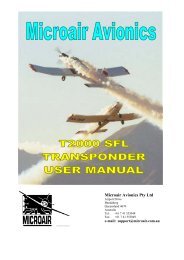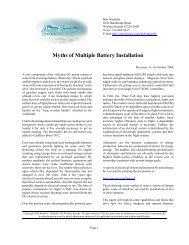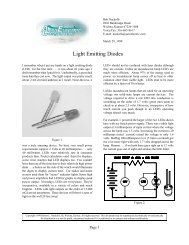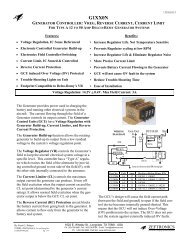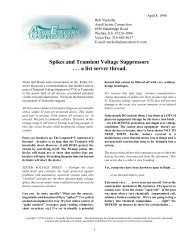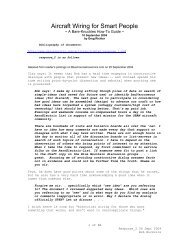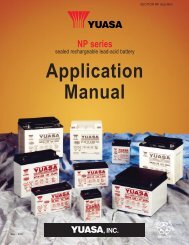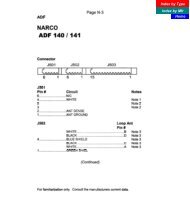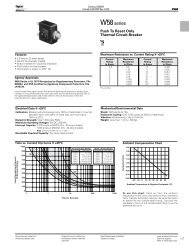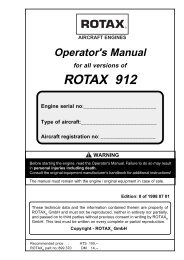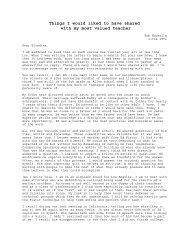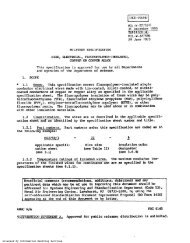TENNA TIP #2 VOR ANTENNAS FOR COMPOSITE AIRCRAFT by ...
TENNA TIP #2 VOR ANTENNAS FOR COMPOSITE AIRCRAFT by ...
TENNA TIP #2 VOR ANTENNAS FOR COMPOSITE AIRCRAFT by ...
- No tags were found...
Create successful ePaper yourself
Turn your PDF publications into a flip-book with our unique Google optimized e-Paper software.
<strong>TENNA</strong> <strong>TIP</strong> <strong>#2</strong><strong>VOR</strong> AN<strong>TENNA</strong>S <strong>FOR</strong> <strong>COMPOSITE</strong> <strong>AIRCRAFT</strong><strong>by</strong> Bob Archer of Sportcraft AntennasIn the first installment I talked mainly about COM antennas so in this one we will discuss internallymounted <strong>VOR</strong> antennas and their installation problems in composite aircraft. The use of <strong>VOR</strong> receivers isdecreasing with the advent of LORAN and GPS but they are still useful and I believe that, as with fuelpumps, you can't have too many backups.Navigation antennas being horizontally polarized require that they be mounted in an area that has a largeenough horizontal area that a half wave dipole can be installed. If the elements are swept the dipole canbe reduced to about 40 inches. The logical locations are the wings, horizontal stabilizer and the top andbottom of the fuselage. There are always gotchas though and wings with large conductive horizontalstructures such as graphite wing spar caps, push rods, cables etc. are not ideal locations. If the antennas inwings can be positioned so that they are about 0.2 wave lengths (about 20 inches ) ahead of the spars orsuch they would have more gain from the front but would reduce signals from the rear. If mounted behindthe spar or other conductive device the reverse would be true and the signal would be stronger from therear.The horizontal tail is a pretty good location for a <strong>VOR</strong> antenna except in the case where the signal iscoming from directly in front and has to pass through the engine and cabin area to arrive at the antenna. Ifthe aircraft is a canard of course the reverse is true. In this condition the signal will be weakened and theCDI needle could possibly wander. This also happens in the case of a metal aircraft with the <strong>VOR</strong>antenna on the top of the vertical stabilizer. When the airframe gets between the transmit and receiveantennas as you approach the <strong>VOR</strong> station there is usually a bit of needle wagging going on.The fuselage is a pretty good location but don't forget about all the stuff in there that can affect theperformance of the antenna. I believe the top of the cabin would be the best bet for the fuselageinstallation of the <strong>VOR</strong> antenna.If your installation has two <strong>VOR</strong> antennas do not connect them together using any means unless youreally, really know what you are doing. Being as far apart as the wing tips are will cause a phasingproblem between the antennas that causes multiple lobes to be formed, the number of lobes beingdetermined <strong>by</strong> the distance apart. Using one antenna for each receiver will result in the increase in rangeof about 25% over one antenna with a two set coupler into two receivers. Try to keep at least a 2" radiuson all RG58/U cable installations. The same things apply to <strong>VOR</strong> antennas that I mentioned last time suchas little black ferrite transformer boxes and ferrite beads. I don't believe that ferrite devices have any placein antennas because they do absorb RF energy.Just a few words on dipole antennas for clarification. There are two types of dipoles: the two element typethat is fed in the center, and is the type that is common and everyone is familiar with and there is also acontinuous conductor type that is a continuous conductor from tip to tip for a full half wavelength. Eachof these types require a different type of feed device. A center fed dipole really should have a baluninstalled for proper operation. Without a balun on a center fed dipole fed with coaxial cable the antennahas uneven currents on the elements because half the currents on the braid side travel down the outside ofthe cable. The impedance is poor because the nominal impedance of this type of dipole is 150 ohms and
is being fed with 50 ohm cable and the radiation pattern is bad because the radiation off the outside of theouter conductor interferes with the radiation off the elements. So a good balun does three things:1. Balances the currents on the elements.2. Matches the impedance of the cable to the elements.3. Chokes off reflected currents that would otherwise travel on the outside of the cable.For those that would rather do it themselves I have enclosed a rather rough sketch of a modified type twobalun, I believe it is, that very neatly solves these problems. I recommend using RG142/U cable ifavailable for its resistance to melting during soldering. By the way those ferrite beads that so manycomposite builders are using are totally useless. The beads do absolutely nothing. And the ones with theferrite transformers in the center are very lossy. Up to 12 dB depending on the type they are using. Istrongly recommend using a real balun.The continuous conductor dipole is interesting in that the center point has an impedance of zero ohms andthe tips have an impedance of infinity, or there about, so somewhere between zero and infinity there isbound to be an impedance point that we could use. If we were to split the conductors apart on a 300-ohmtwin lead cable and attach a conductor to the 150-ohm point on each side of the neutral center we wouldhave a very good antenna. To feed with a 50 ohm cable though is a bit more of a problem. What we needto do here is to connect the braid of the cable to the neutral center point and the center conductor to the50-ohm point on one side. A problem arises in that in connecting the center conductor to the antennaelement we introduce an inductive loop that needs to be balanced out with a series capacitance. When allthe parameters are correct this also becomes a very good antenna. This antenna design allows control ofthe length, feed point impedance and capacitance/inductance relationships so can be tuned to a high levelof performance. Specialized antenna measuring must be used for tuning this type of dipole. Most of myantennas are designed in this manner.Next time I will see how far I get going through the list of remaining aircraft antennas such as ADF,Transponder, GPS, etc.Bob ArcherSportcraft Antennas21818 Ocean Ave.Torrance, Cal., 90503Tel. 310-316-8796E mail
• Radiation Pattern? A pattern showing the relative signal level around an antenna. Signal strengthcan be severely reduced in particular directions <strong>by</strong> other antennas, vertical stabilizers, landing gearsetc.• Balun? A device that converts a balanced transmission line (such as TV lead in) to a coaxial linewhich is an unbalanced line. Provides balanced currents on dipole antennas while matching the 50-ohm line to the nominally 150-ohm antenna.• Polarization? The plane in which RF energy is radiated. Normally either vertical, such as COM, orhorizontal, such as <strong>VOR</strong>, or any angle in between, such as bent COM antennas. There is also circularpolarization, which we will discuss along with GPS antennas.



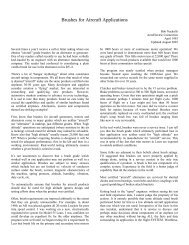
![G-Series-Ext [pdf] - Carling Technologies](https://img.yumpu.com/50918301/1/190x245/g-series-ext-pdf-carling-technologies.jpg?quality=85)
